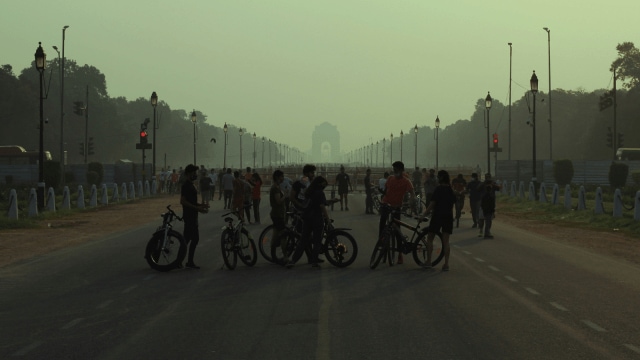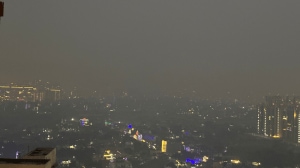Worst Diwali night air in Delhi in at least 3 years as firecrackers burst almost non-stop
According to CPCB data, Delhi’s air quality on Diwali this year (AQI 345) was worse than last year (328 in 2024), and higher than the previous two years — 218 in 2023 and 312 in 2022
 Delhi's air quality is expected to further dip as winter approaches
Delhi's air quality is expected to further dip as winter approachesPollution levels in Delhi spiked sharply through Diwali night on Monday, with the Delhi Pollution Control Committee (DPCC) real-time data showing PM2.5 and PM10 concentrations breaching safe limits by 15 to 18 times across several stations.
Anand Vihar, Dwarka Sector 8, Patparganj, and Jahangirpuri recorded peaks above 1,400 to 1,800 µg/m³, which is 15-20 times higher than the permissible standards.
The city’s air quality index (AQI) at 11 pm, as per Central Pollution Control Board (CPCB) data, stood at 347, in the ‘very poor’ category. It remained nearly unchanged, at 346 at 6 am Tuesday, and by 11 am it had reached 359.
This year’s Diwali pollution levels were the highest in recent years. This is significant especially as this year the Supreme Court relaxed ban on firecrackers to allow less polluting ‘green’ crackers.
According to CPCB data, Delhi’s air quality on Diwali this year (AQI 345) was worse than last year (328 in 2024), and higher than the previous two years — 218 in 2023 and 312 in 2022.
Hourly data also showed sharper night-time spikes despite Diwali being early this year, with several stations recording PM2.5 and PM10 concentrations above 1,500 µg/m³, unlike last year when the highest spike was around 1525µg/m³, at Nehru Nagar.
This Diwali night, the Nehru Nagar PM2.5 peak concentration reached 1,763 µg/m³ around 10 pm, which was almost 30 times the national 24-hour permissible limit of 60 µg/m³.
The spikes that began around 8 pm on Monday and intensified past midnight, coinciding with the widespread bursting of firecrackers across the city.
According to DPCC data, Anand Vihar recorded the highest PM10 concentration at 1,824 µg/m³ around 2 am, followed closely by Dwarka Sector 8 (1,602 µg/m³ at 10 pm), Patparganj (1,591 µg/m³ at 10 pm), and Jahangirpuri (1,486 µg/m³ at 1 am).
Also Read | Post-Diwali AQI shoots up in four Metro cities, Bengaluru records ‘good’ air quality
Among PM2.5 readings, the highest concentrations were logged at Nehru Nagar (1,763 µg/m³ at 10 pm), R K Puram (1,476 µg/m³ around midnight), Punjabi Bagh (1,432 µg/m³ at 1 am) and Sri Aurobindo Marg (1,431 µg/m³ at 4 am).
Stations such as Mundka, Ashok Vihar, and Okhla Phase 2 also reported values exceeding 1,000 µg/m³ during late-night hours.
At several locations, data were missing for multiple hours between 11 pm and 5 am, suggesting possible instrument saturation due to extremely high particulate concentrations.
For instance, stations at Patparganj, Nehru Nagar, JLN Stadium, and Okhla Phase 2 had gaps through the night, resuming early morning with readings still several times the safe limits.
Even in the morning hours, the particulate matter pollution remained high. But by 9 am on Tuesday, pollution levels, though still elevated, had reduced sharply due to wind conditions.
Most stations still recorded PM2.5 between 300 and 500 µg/m³, nearly five to eight times above the 24-hour permissible limit of 60 µg/m³. For instance, Mandir Marg reported 365 µg/m³, Sonia Vihar 333 µg/m³, and Rohini around 396 µg/m³ at 9 am.
Dr Mohan George, former Additional Director at DPCC, pointed at the gaps in monitoring with several stations including Najafgarh and Anand Vihar showing missing data.
“Many stations have data missing from 11 pm to 6 am… If this was a ‘Green Deepawali’, then the public deserves to know what exactly they breathed during the night,” Mohan George, former additional chairperson of the DPCC, said.
“Why was CPCB’s continuous air quality tracking unavailable for several hours, and why did most monitoring stations show missing data during the peak pollution window?,” he said.
Questions asked of DPCC remained unanswered immediately. The report will be updated as soon as responses are received.







